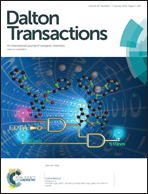Secondary diphosphine and diphosphido ligands: synthesis, characterisation and group 1 coordination compounds†
Abstract
Two types of secondary diphosphines, 1,8-(ArPH)2C14H8 (1a: Ar = Tripp, 2,4,6-triisopropylphenyl; 1b: Ar = Mes, 2,4,6-trimethylphenyl) and 1,3-(tBuPHCH2)2C6H4 (2), based on rigid 1,8-anthracene and flexible m-xylyl frameworks, respectively, have been synthesized using different strategies. Compounds 1a and 1b were formed by nucleophilic aromatic substitution of a potassium organophosphido salt onto 1,8-difluoroanthracene, while compound 2 was obtained by addition of the Grignard reagent [1,3-(ClMgCH2)2C6H4]x to a dichloroorganophosphine, followed by reduction to the diphosphine. These compounds were isolated as ca. 1 : 1 mixtures of rac and meso diastereomers as determined by multinuclear NMR spectroscopy. Borane and selenide derivatives of 2, 1,3-(tBuPH(BH3)CH2)2C6H4 (3) and 1,3-(tBuPH(Se)CH2)2C6H4 (4), were obtained. Preferential crystallization of one diastereomer of 3 and 4 was observed; X-ray crystallographic studies identified this as the rac isomer for diselenide 4. Metallation studies of compounds 1a and 2 yielded several alkali metal salts. The reaction of KH or K metal with 1a yielded the compounds 1,8-(TrippPK)2C14H8·xTHF (5) and 1,8-(TrippPK)2C14H10·xTHF (6), respectively; in complex 6 the central aromatic ring has been reduced to yield a bent dihydroanthracene backbone. A crown ether derivative of 6, [K(18-crown-6)(THF)2]2[1,8-(TrippP)2C14H10] (7), was characterised crystallographically. Double deprotonation of compound 2 with nBuLi/TMEDA (TMEDA = N,N,N′,N′-tetramethylethylenediamine) afforded the yellow dilithium complex 1,3-(tBuPLiCH2)2C6H4·TMEDA (8), which crystallized as a dimer featuring lithium–arene π interactions.


 Please wait while we load your content...
Please wait while we load your content...